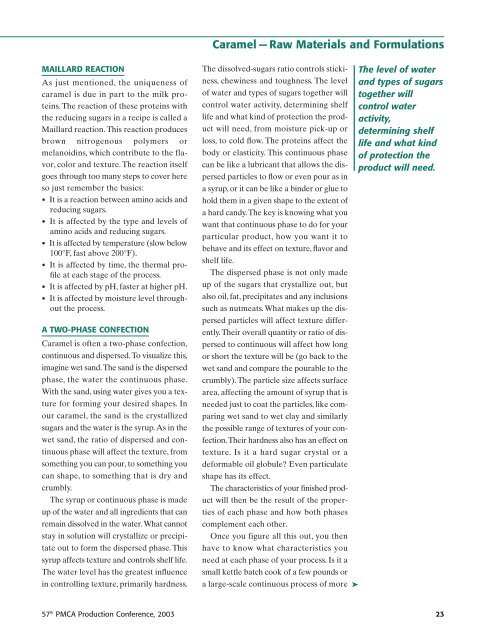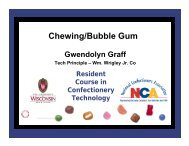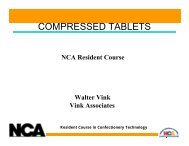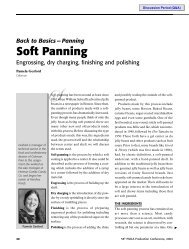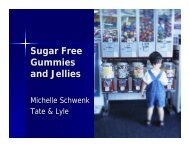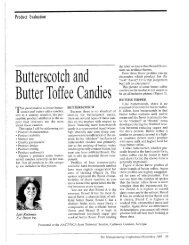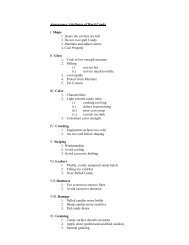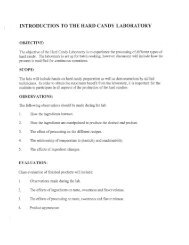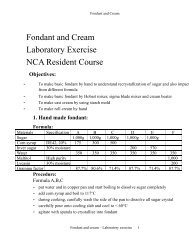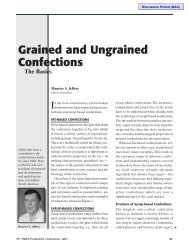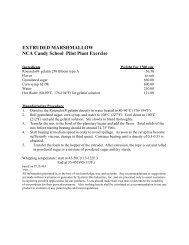2003 Caramel--Raw Materials and Formulations - staging.files.cms ...
2003 Caramel--Raw Materials and Formulations - staging.files.cms ...
2003 Caramel--Raw Materials and Formulations - staging.files.cms ...
You also want an ePaper? Increase the reach of your titles
YUMPU automatically turns print PDFs into web optimized ePapers that Google loves.
MAILLARD REACTION<br />
As just mentioned, the uniqueness of<br />
caramel is due in part to the milk proteins.<br />
The reaction of these proteins with<br />
the reducing sugars in a recipe is called a<br />
Maillard reaction. This reaction produces<br />
brown nitrogenous polymers or<br />
melanoidins, which contribute to the flavor,<br />
color <strong>and</strong> texture. The reaction itself<br />
goes through too many steps to cover here<br />
so just remember the basics:<br />
• It is a reaction between amino acids <strong>and</strong><br />
reducing sugars.<br />
• It is affected by the type <strong>and</strong> levels of<br />
amino acids <strong>and</strong> reducing sugars.<br />
• It is affected by temperature (slow below<br />
100°F, fast above 200°F).<br />
• It is affected by time, the thermal profile<br />
at each stage of the process.<br />
• It is affected by pH, faster at higher pH.<br />
• It is affected by moisture level throughout<br />
the process.<br />
A TWO-PHASE CONFECTION<br />
<strong>Caramel</strong> is often a two-phase confection,<br />
continuous <strong>and</strong> dispersed.To visualize this,<br />
imagine wet s<strong>and</strong>.The s<strong>and</strong> is the dispersed<br />
phase, the water the continuous phase.<br />
With the s<strong>and</strong>, using water gives you a texture<br />
for forming your desired shapes. In<br />
our caramel, the s<strong>and</strong> is the crystallized<br />
sugars <strong>and</strong> the water is the syrup.As in the<br />
wet s<strong>and</strong>, the ratio of dispersed <strong>and</strong> continuous<br />
phase will affect the texture, from<br />
something you can pour, to something you<br />
can shape, to something that is dry <strong>and</strong><br />
crumbly.<br />
The syrup or continuous phase is made<br />
up of the water <strong>and</strong> all ingredients that can<br />
remain dissolved in the water.What cannot<br />
stay in solution will crystallize or precipitate<br />
out to form the dispersed phase. This<br />
syrup affects texture <strong>and</strong> controls shelf life.<br />
The water level has the greatest influence<br />
in controlling texture, primarily hardness.<br />
<strong>Caramel</strong> — <strong>Raw</strong> <strong>Materials</strong> <strong>and</strong> <strong>Formulations</strong><br />
The dissolved-sugars ratio controls sticki- The level of water<br />
ness, chewiness <strong>and</strong> toughness. The level <strong>and</strong> types of sugars<br />
of water <strong>and</strong> types of sugars together will together will<br />
control water activity, determining shelf control water<br />
life <strong>and</strong> what kind of protection the prod- activity,<br />
uct will need, from moisture pick-up or determining shelf<br />
loss, to cold flow. The proteins affect the life <strong>and</strong> what kind<br />
body or elasticity. This continuous phase of protection the<br />
can be like a lubricant that allows the dis- product will need.<br />
persed particles to flow or even pour as in<br />
a syrup, or it can be like a binder or glue to<br />
hold them in a given shape to the extent of<br />
a hard c<strong>and</strong>y.The key is knowing what you<br />
want that continuous phase to do for your<br />
particular product, how you want it to<br />
behave <strong>and</strong> its effect on texture, flavor <strong>and</strong><br />
shelf life.<br />
The dispersed phase is not only made<br />
up of the sugars that crystallize out, but<br />
also oil, fat, precipitates <strong>and</strong> any inclusions<br />
such as nutmeats. What makes up the dispersed<br />
particles will affect texture differently.Their<br />
overall quantity or ratio of dispersed<br />
to continuous will affect how long<br />
or short the texture will be (go back to the<br />
wet s<strong>and</strong> <strong>and</strong> compare the pourable to the<br />
crumbly). The particle size affects surface<br />
area, affecting the amount of syrup that is<br />
needed just to coat the particles, like comparing<br />
wet s<strong>and</strong> to wet clay <strong>and</strong> similarly<br />
the possible range of textures of your confection.Their<br />
hardness also has an effect on<br />
texture. Is it a hard sugar crystal or a<br />
deformable oil globule? Even particulate<br />
shape has its effect.<br />
The characteristics of your finished product<br />
will then be the result of the properties<br />
of each phase <strong>and</strong> how both phases<br />
complement each other.<br />
Once you figure all this out, you then<br />
have to know what characteristics you<br />
need at each phase of your process. Is it a<br />
small kettle batch cook of a few pounds or<br />
a large-scale continuous process of more ➤<br />
57 th PMCA Production Conference, <strong>2003</strong> 23


